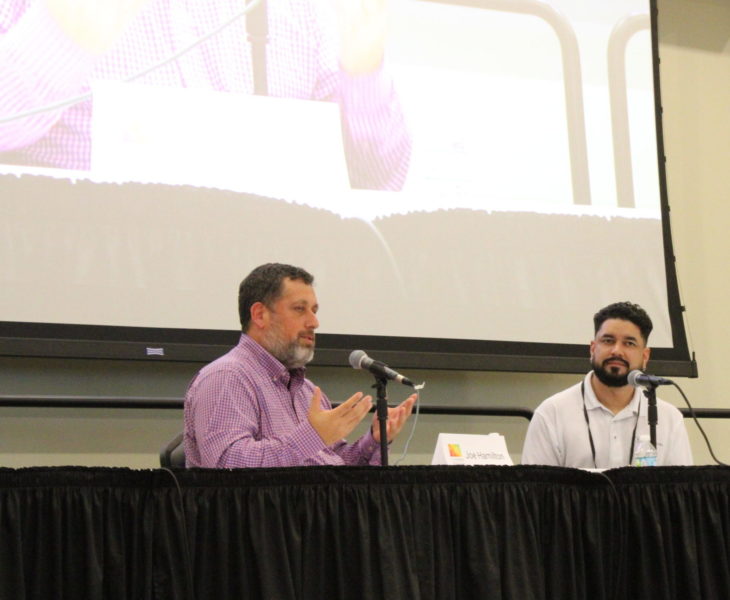‘Security through transparency’: How blockchain is changing global business

On the final day of the St. Petersburg Conference on World Affairs, two local experts broke from the mold of discussing the world’s problems, focusing instead on emerging global opportunities through blockchain technology.
As the international conference came to a close Friday, St. Pete Catalyst publisher and Metacity Head of Network Joe Hamilton took the stage at the University of South Florida St. Petersburg with BlockSpaces Co-Founder Gabe Higgins. In addition to those inside the ballroom, organizers announced a global streaming audience of 2,500 for the second-to-last presentation of the four-day event, breaking the previous record by 500 viewers.
The discussion explained how blockchain technology, cryptocurrency and decentralized finance are rapidly changing the landscape of international business. Higgins, whose Tampa-based blockchain integration platform raised over $7.25 million in venture funding in less than a year, put the precipitous adoption of Bitcoin in perspective.
“It took Apple – the largest company in the world as far as market capitalization and value – it took them like 24 years to get to the trillion-dollar in value mark,” he said. “Facebook, it took them 18 years to get to a trillion dollars of value.
“But Bitcoin, it took Bitcoin 12 years to get to a trillion dollars. It’s growing faster than the internet itself did in the ’90s.”
Bitcoin and blockchain technology are intrinsically intertwined, as the alpha crypto was the first to apply the innovative data structure in 2009. By 2014, people began to realize blockchain’s potential in global financial and inter-organizational transactions.
Higgins said blockchain solved the longstanding computer science problem of preventing outside sources from replicating digital information ad infinitum. The technology allows for the worldwide coordination of human efforts, and the entire system is governed by open-source code, eliminating the corruptible hierarchy typically found in such endeavors.
“I liken it to a permanent record for the world,” said Hamilton. “It’s security through transparency.”
Higgins said that blockchain and cryptocurrency eliminate the need to trust several financial institutions when transacting, especially internationally. Blockchain technology also alleviates friction caused by a cumbersome chain of custody and varying regulatory environments. He said that friction, and its associated risks, lead to real-world costs and side effects.
Higgins explained with the first iteration of the web, people could simply read information stored on the internet. With the next form of the internet, Web 2.0, people could read, write and freely publish information. Web 2.0 led to Big Data and social media conglomerates, putting the majority of control over the internet into a few centralized entities.
Higgins called Web3, which developers and technologists are currently in the process of building, “the value dimension.” Web3 allows for digital ownership and enables users to maintain and control their digital assets. Higgins said people with both good and bad intentions now realize ways to utilize these innovative technologies.
“You do have nefarious activities that are also very much up to speed with the latest technologies – which has always been the case,” said Higgins. “So, we do have to guard against those things, but for the most part, it’s beneficial for humanity.”
To further illustrate blockchain’s utility in global business, Hamilton relayed how he employs a graphic designer in South Africa. He said it is easier to get on a plane and fly to South Africa than wiring payments in dollars due to widespread corruption and regulatory hurdles.
Blockchain and cryptocurrency allow him to transfer money to his CashApp account, convert it to bitcoin and seamlessly send it to his employee.
“That whole thing takes less than three minutes, and it cost me like 12 cents,” said Hamilton. “That’s utility, and that’s why it’s not tulip bulbs.”
The new technologies have also caused a significant shift in what people consider stores of value. Many people have turned to non-fungible tokens (NFTs) to keep pace with an increasingly digital world. NFTs prove ownership through blockchain verification, and Hamilton realizes the lack of understanding on how arguably rudimentary pictures are now selling for millions of dollars as NFTs.
Hamilton used the U.S. Constitution as an analogy. A copy of the Constitution, he noted, recently sold for $42 million, a value many accept due to its scarcity and historical significance. He said its worth is tied to its authenticity, and the time and place it represents. If someone later discovered several more copies of the Constitution, or if the copy sold for $42 million was a fake, its value would plummet.
Hamilton said that if Elon Musk lands on Mars and writes the red planet’s constitution, it won’t be with a quill pen and parchment paper but through a computer. That constitution would still have historical significance and great value, with no chance for forgeries.
“That’s what this digital, permanent record allows people to do,” said Hamilton. “This (NFTs) is the new accepted vehicle for value that our kids will think is completely normal, even though we think it’s completely nuts.”
Higgins described other uses for NFTs, such as their ability to function as a literal key. He said someone could employ smart locks on their house, car or whatever they would like to secure, and the only way to gain access is through an NFT stored on a mobile device.
Higgins said NFTs offer a mathematically secure way to generate passcodes that are impossible to replicate or manipulate.
“If you own it, you own it,” said Higgins. “You’re removing any kind of counterparty risk involved with you being able to utilize your asset in a specific way.”
Large institutions are beginning to realize the utility blockchain technology brings to the world. Higgins announced a partnership between USF and BlockSpaces to create a digital identity for students. He said the university could issue certificates and diplomas as a digital asset verifiable in perpetuity through the blockchain.
Walmart is also on the leading edge of utilizing blockchain technology. Higgins said the global conglomerate employs five different blockchains across 10 separate divisions. One of the most successful uses is tracking produce through the vast supply chain network for regulatory compliance and safety measures.
Higgins recalled that during a 2020 E. coli outbreak, Walmart had to remove all of its romaine lettuce from store shelves. For weeks, Walmart wasted produce, time and manpower sifting through a paper trail because supply chain records existed through pen and paper.
“It turned out it was just one bad batch on one farm,” said Higgins. “And for that, the entire industry suffered. If that information was digitized, you could instantly discover where that bad batch came from.”
Higgins said following that costly miscue, Walmart launched its Food Trust Network to trace produce using the blockchain.
Higgins encouraged those in attendance and watching around the world to keep an open mind on the emerging technology and stay curious. He said there is still much to discover, and applications are evolving to match the ever-changing global business landscape.
“When I started getting involved in Bitcoin in late 2012, I didn’t realize how much it would impact the world,” he said.







